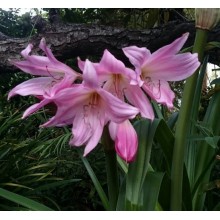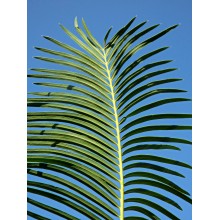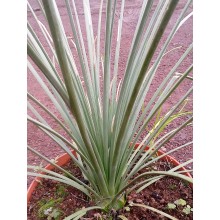Plantes résistantes au froid Il y a 317 produits.

Voici notre sélection de plantes qui peuvent supporter un certain froid. Certaines ne vont pas résister au froid et supporteront un gel léger, mais d'autres supporteront bien les gelée dans les climats froids. Elles sont tous très différentes mais méritent d'être essayées parce que tous ces plantes tropicales ont des exigences non tropicales. Elles vont sûrement prospérer en extérieur dans des climats méditerranéens côtiers ou dans une serre chauffée légèrement où le gel ne passera pas.
-
Crinum moorei LARGE
Crinum moorei LARGE
This flowering bulb native to South Africa grows into a large clump of elegant flat wide leaves, up to 1 m long. Bulbs are very large, up to 20 cm in diameter and the mostly stay above soil. It is a supreme Crinum for the garden and takes light frost. We ship a gigantic bulb, ready to bloom in less than one year.
67,80 € -
Crinum x 'Infusion'
Crinum x 'Infusion'
Frost hardy hybrid crinum developed in the USA by crossing two of the most outstanding Crinums: 'Ellen Bosanquet' and 'J.C. Harvey'. The result is spectacular: Leaves are glossy and tropical looking, blooms are deep pink with a supreme scent.
32,00 € -
Crinum x Powellii
Crinum x Powellii
This Crinum is an old, classic hybrid which is a re-bloomer (it blooms at least twice a year). Umbels hold about 10 large pink flowers. It is resistant to mild frosts.
32,00 € -
Crinum x Powellii LARGE
Crinum x Powellii LARGE
This Crinum is an old, classic hybrid which is a re-bloomer (it blooms at least twice a year). Umbels hold about 10 large pink flowers. It is resistant to mild frosts.
75,40 € -
Cycas panzhihuaensis
Cycas panzhihuaensis
Distinct Chinese cycad, from inland colder aereas, characterised by the short stout trunks with a thick coat of orange-brown wool.We offer a plant of this size: H= 50-60 cm Base: 3-4 cm
57,20 € -
Cycas revoluta
Cycas revoluta
Cycas revoluta is a slow-growing, evergreen palm-like plant with an erect main stem that is usually around 0.5 - 2 metres tall, often with few basal branches, but sometimes aerially branched.
24,30 € -
Cycas shanyaensis
Cycas shanyaensis
NEW ! H = 50-110 cm. Base = 5-7 cm. 5 years. New Chinese species described in 2006 from cool mountain forests between 700 and 800 m (2300 and 2600 ft) near the city of Shanya, on the island of Hainan.
118,00 € -
Cycas x 'Rev Form' (C.revoluta x C.debaoensis F2)
Cycas x 'Rev Form' (C.revoluta x C.debaoensis F2)
This is a second generation (F2) cross of Cycas debaoensis and C. revoluta. This means that all our seedlings are not an exact mix of the two species as it was in the first generation F1.
165,00 € -
Cydonia oblonga 'Vranja' - Cognassier
Cydonia oblonga 'Vranja' - Cognassier
Vranja' is possibly the best known cultivar of Quince and it has gained the Royal Horticultural Society's Award of Garden Merit.
47,00 € -
Dasylirion cedrosanum
Dasylirion cedrosanum
Dasylirion cedrosanum is a little known sotol from in the Mexican states of Chihuahua, Coahuila, and Durango. In these areas, Dasylirion cedrosanum grows among shrubs or grasses, at 1.000-2.000 m elevation.
23,00 € -
Dasylirion lucidum
Dasylirion lucidum
Pale green leaves open up in tufts of fluffy fibres. A robust Dasylirion from high altitude desert regions in central Mexico that develops a short trunk, often holding multiple crowns of pale green leaves with frayed leaf tips. Native to dry areas of Oaxaca and Puebla, in Mexico.
23,00 € -
Dasylirion texanum
Dasylirion texanum
This species is typically smaller than other Dasylirions, with small crowns and trunks usually less than 0,5 m. Leaves are long, reaching 1–2m.
24,30 € -
Deuterocohnia brevifolia ssp. chlorantha
Deuterocohnia brevifolia ssp. chlorantha
Clump of 6-10 heads - Small, terrestrial, cushion-forming plant species. It is probably one of the cold hardiest of the bromeliads.
31,00 € -
Deuterocohnia brevifolia ssp. chlorantha –LARGE
Deuterocohnia brevifolia ssp. chlorantha –LARGE
Clump of >30 heads. 12 cm diameter ! - Small, terrestrial, cushion-forming plant species. It is probably one of the cold hardiest of the bromeliads.
151,30 € -
Dianella caerulea
Dianella caerulea
Blue flax-lily or blueberry is a perennial ornamental from Eastern Australia and Tasmania, with glossy green blade-like leaves to 70 cm long. Blue flowers are produced in spring and summer and purple berries are kept througout autumn. It is hardy to drought, snow and frost, to at least -7 C.
10,90 € -
Dianella tasmanica 'Variegata'
Dianella tasmanica 'Variegata'
Stable variegated clone with white stripes. This dianella looks good in any conditions and it is always great in the garden or in individual pots.
15,70 €
Pour le moment, il ya peu de produits dans cette catégorie Plantes résistantes au froid
























































